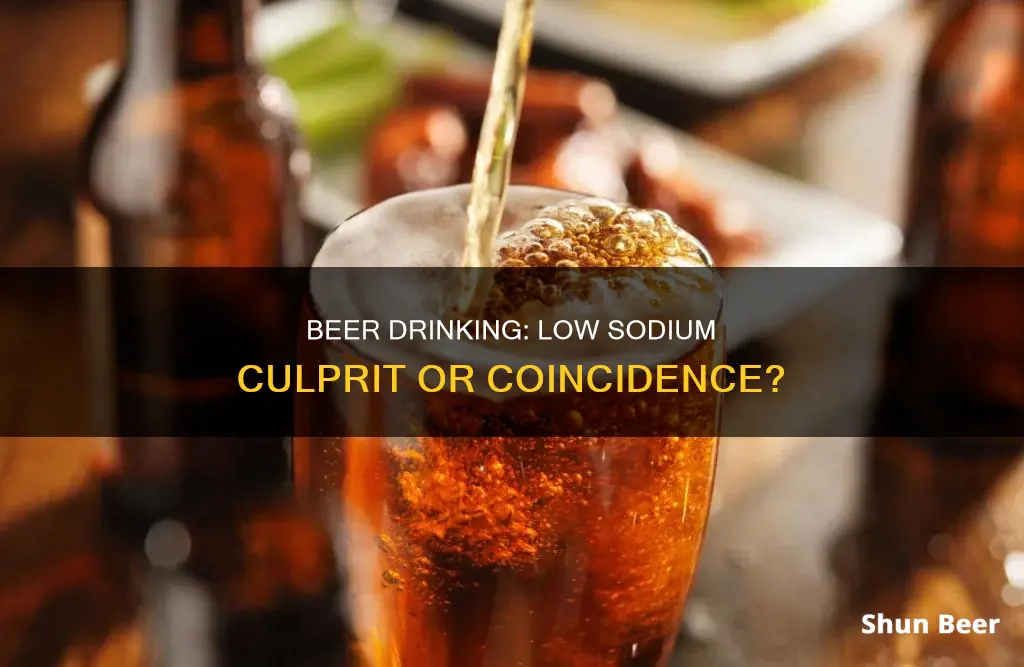
Drinking large quantities of beer can cause a condition known as beer potomania, which can lead to abnormally low sodium levels in the blood, a condition known as hyponatremia. This occurs due to the combination of excessive beer consumption, which has a high water and low sodium content, and poor nutritional intake, particularly a low sodium diet. Beer potomania can have serious health consequences, including neurological issues, seizures, and even death, and requires careful medical treatment to avoid complications.
| Characteristics | Values |
|---|---|
| What is beer potomania? | A condition when sodium levels in the blood drop dangerously as a result of binge drinking beer. |
| What causes beer potomania? | A combination of regularly binge drinking beer and a lack of proper eating and nourishment. |
| Who is at risk of beer potomania? | Those who drink excessive amounts of beer and do not get enough sodium in their diet. |
| What are the symptoms of beer potomania? | Weakness, gait disturbance, altered mental state, muscle cramps and weakness, dizziness, fatigue, irritability, restlessness, nausea, vomiting, headache, seizures, coma. |
| How is beer potomania treated? | Doctors recommend a slow and careful administration of sodium over the course of 48 hours. |
| How can beer potomania be prevented? | By eating healthy, nutritious meals and reducing or avoiding alcohol intake. |
What You'll Learn

Beer contains a lot of water and very little sodium
Beer potomania, or beer drinker's hyponatremia, is a condition in which the level of sodium in the blood becomes dangerously low due to excessive beer consumption. This occurs because beer contains a lot of water and very little sodium. This lopsided water-to-salt ratio can cause issues for those who are already at high risk of potomania, especially when sodium and protein-rich food intake is also low.
Sodium is an important nutrient that helps regulate the balance of water in the body. It plays a crucial role in maintaining proper kidney function and preventing fluid buildup. When someone stops eating, their body breaks down fat and muscle for energy, which provides enough sodium to keep the kidneys functioning. However, excessive beer consumption dilutes this sodium, making it ineffective.
The high water content and low sodium content of beer can lead to fluid buildup in the cells, as there is not enough sodium in the body to maintain the balance. This is especially true for individuals who have poor overall nutrition and rely on alcohol for most of their calories. The sodium in the bloodstream becomes diluted by the excess fluid, causing a rapid and severe drop in sodium levels.
The symptoms of beer potomania include an altered mental state, muscle weakness or cramps, fatigue, irritability, and in severe cases, coma. It is a serious condition that requires medical attention and can be avoided by improving nutritional intake and reducing alcohol consumption.
While it may seem intuitive to treat beer potomania by simply increasing sodium levels, this approach can be dangerous. Rapid correction of sodium levels can lead to neurological problems, including osmotic demyelination syndrome (ODS), which can cause severe mental impairment and coma. Therefore, doctors recommend a slow and careful administration of sodium over 48 hours to avoid these complications.
Beer Drinking and Weight Gain: Is There a Link?
You may want to see also

Sodium regulates water balance in the body
Sodium is the principal extracellular cation in the body and is the most important osmotically active solute. It is essential to the body, but a high salt intake can have negative health effects over time. The body maintains homeostasis by protecting sodium balance more vigorously than it does water balance or acid-base balance.
The kidneys are the most important control point for both sodium and water. The body aims to preserve plasma osmolality (saltiness) between 275-300 mOsm/kg and sodium levels between 135-145 mEq/L. When the body's sodium or water levels get too high, sensors in the heart, blood vessels, and kidneys detect this and set in motion processes that lead to their greater excretion through the kidneys. In contrast, when blood plasma volume or sodium concentration becomes too low, the sensors trigger processes that increase their reabsorption through the kidneys.
The body's endocrine system, a complex chemical messaging system made up of feedback loops of hormones, regulates these functions and processes. The antidiuretic hormone (ADH), also known as vasopressin, is responsible for regulating the body's retention of water. It is secreted by the hypothalamus in response to an increase in plasma osmolality, decreased blood volume, decreased blood pressure, and/or stress. ADH acts on the nephrons of the kidneys, facilitating greater reabsorption of water by increasing the water permeability of the cell walls. This results in increased passive movement of water out of the kidney and back into the bloodstream, leading to a reduced volume of urine.
The kidney also plays a crucial role in sodium balance. When there is a depletion of sodium, such as through extreme sweating or a chronically low sodium diet, it results in low plasma volume and low blood pressure. These low blood pressures throughout the cardiovascular system are recognised by baroreceptors (pressure sensors in the blood vessels). This causes a decrease in the glomerular filtration rate, which is the volume of fluid filtered through the kidneys, leading to less opportunity for sodium to be lost through urinary excretion. The hormone aldosterone, secreted by the adrenal glands, also plays a role in sodium reabsorption.
While most people get sufficient sodium from their diet, those who stop eating or have poor nutritional intake can experience a drop in sodium levels. This is particularly common among people who misuse alcohol, as they may get most of their calories from drinking beer and other alcoholic beverages. Beer contains a lot of water and only a small amount of sodium, which can lead to a condition called "beer potomania" or "beer drinker's hyponatremia". This condition is characterised by dangerously low sodium levels in the blood due to excessive beer consumption and can have severe health consequences, including seizures, coma, and even death.
Beer After Best Before Date: Is It Safe to Drink?
You may want to see also

Beer potomania can be avoided by eating healthy and reducing alcohol intake
Beer potomania, also known as beer drinker's hyponatremia, is a condition that arises from excessive beer consumption and inadequate sodium intake. It is characterised by a dangerously low level of sodium in the blood, which can lead to a host of serious health issues. However, this condition can be effectively avoided by adopting certain preventive measures, specifically by eating healthy and reducing alcohol intake.
To understand how beer potomania can be prevented, it is important to grasp the underlying causes. Firstly, beer has a high water content and a low sodium content. When individuals with a high-risk profile for potomania, such as those with low sodium intake, binge drink large quantities of beer, it can trigger the condition. This is exacerbated by a lack of proper nutrition, which is common among those who abuse alcohol.
Therefore, the key to preventing beer potomania lies in addressing these risk factors. Here are some strategies to avoid beer potomania:
- Maintain a Healthy Diet: Ensuring adequate sodium intake through a healthy diet is crucial. Include sodium-rich foods in your meals, such as salted nuts, pickles, cured meats, cheese, and soy sauce. Additionally, focus on consuming a well-balanced diet that includes all the major food groups: fruits, vegetables, low-fat dairy products, lean proteins, and healthy fats.
- Limit Alcohol Consumption: Reducing alcohol intake, especially beer, is essential for preventing beer potomania. If you choose to drink, do so in moderation and always accompany alcohol with food, especially salty and protein-rich snacks like beef jerky or nuts. Avoid binge drinking, as it significantly increases the risk of developing beer potomania.
- Address Alcohol Addiction: If you or someone you know struggles with alcohol addiction, seeking professional help is vital. Alcohol addiction treatment specialists can provide support through detox and withdrawal programs, treatment planning, psychological counseling, medications, and support groups. These interventions can help manage alcohol consumption and reduce the risk of beer potomania and other alcohol-related health complications.
- Monitor Sodium Levels: For those at high risk of beer potomania, regular monitoring of sodium levels is important. This is especially true if you have a history of alcohol abuse, poor dietary habits, or experience symptoms such as dizziness, muscle weakness, and altered mental state. Early detection of hyponatremia can help guide appropriate treatment and prevent severe neurological consequences.
- Practice Hydration Awareness: While water is essential for health, excessive water consumption can contribute to hyponatremia. Be mindful of your total fluid intake, including water and other beverages, to ensure it aligns with your activity level and dietary sodium intake. However, always prioritise staying hydrated, as dehydration can also have adverse health effects.
By following these guidelines, you can effectively avoid beer potomania and maintain your health. Remember, if you or a loved one is struggling with alcohol addiction, don't hesitate to seek professional help.
Mastering Beer: CFT Mastercan's Magic
You may want to see also

Beer potomania can be life-threatening if left untreated
Beer potomania, also known as beer drinker's hyponatremia, is a condition caused by excessive beer consumption and poor nutrition. It leads to dangerously low levels of sodium in the blood, a condition called hyponatremia. While not everyone who drinks beer will experience this condition, it can have life-threatening consequences if left untreated.
Hyponatremia is characterised by a lack of sodium in the blood, which disrupts the balance between sodium and water levels in the body. This imbalance results in an increase in water in the blood cells and the surrounding areas, causing them to swell. The severity of symptoms depends on how quickly the sodium levels drop. A slow decrease over several days or weeks may result in mild symptoms, while a rapid drop within 24 to 48 hours can lead to life-threatening complications.
When sodium levels fall too low, it can cause cerebral edema, or swelling in the brain, which can lead to seizures, coma, and even death. Other symptoms of beer potomania include dizziness, muscle weakness, neurological impairment, and an altered mental state. In some cases, individuals may experience nausea, vomiting, headache, and loss of consciousness.
The treatment for beer potomania requires a delicate approach. While it may seem intuitive to increase sodium levels, doing so too quickly can lead to neurological problems such as osmotic demyelination syndrome (ODS). ODS can cause severe mental impairment and coma. Therefore, doctors recommend slowly administering sodium over a period of 48 hours to avoid these complications.
To prevent beer potomania, it is important to maintain a healthy diet with sufficient sodium intake and to limit alcohol consumption. For those struggling with alcohol addiction, seeking help is crucial to reduce the risk of developing serious conditions such as beer potomania.
Drinking 16 Beers: Is It Possible or Dangerous?
You may want to see also

Treatment for beer potomania must be careful to avoid neurological issues
Beer potomania is a condition where sodium levels in the blood drop dangerously due to excessive beer consumption. The condition is characterised by a high ratio of water and a low ratio of sodium in the beer, which causes problems for those who are already at high risk of potomania. This is especially true for those whose daily sodium intake is low.
Treating beer potomania requires caution to avoid causing a condition known as osmotic demyelination syndrome (ODS). ODS is a severe neurological issue that can be caused by the rapid reversal of sodium levels. ODS can lead to spasms, severe mental impairment, and coma. In a review of 22 cases of beer potomania, 18% of people developed ODS.
To avoid ODS, doctors recommend a slow and careful administration of sodium over 48 hours. If the patient is not experiencing symptoms, doctors may decide to withhold IV fluids with sodium and instead put the patient on a liquid-restricted diet for at least 24 hours. This gives the body time to expel extra fluids and build up sodium concentration naturally.
Beer potomania can be avoided by improving nutrition and reducing alcohol intake. If you or someone you know is suffering from alcohol addiction, seeking help can prevent serious conditions such as beer potomania.
Beer and Lipitor: Safe Mix or Health Risk?
You may want to see also
Frequently asked questions
Beer potomania, also known as beer drinker's hyponatremia, is a condition characterised by low sodium levels in the blood as a result of excessive beer consumption and poor nutrition.
Symptoms of beer potomania include dizziness, muscular weakness, fatigue, irritability, and nausea. In severe cases, it can lead to seizures, coma, or even death.
To prevent beer potomania, it is important to maintain a healthy and balanced diet, ensure adequate sodium intake, and drink beer in moderation. If you struggle with alcohol addiction, seek professional help to reduce your risk of developing this condition.







